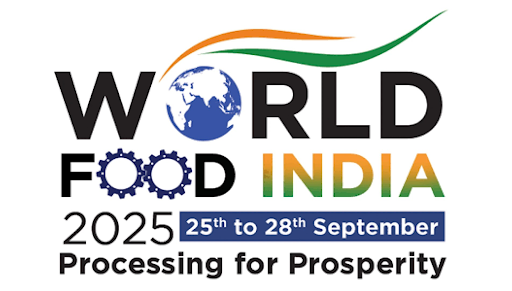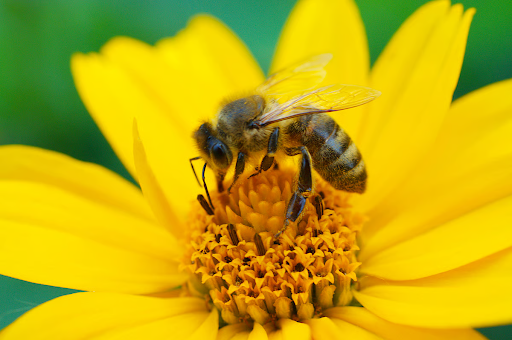Description

Disclaimer: Copyright infringement not intended.
Context
- The Cabinet Committee on Economic Affairs chaired by Prime Minister Narendra Modi has approved minimum support prices (MSP) for copra for 2023 season.
- The approval is based on the recommendations of the Commission for Agricultural Costs and Prices (CACP) and views of major coconut-growing states.
Details
- The MSP for fair average quality of milling copra has been fixed at Rs. 10,860 per quintal and for ball copra at Rs. 11,750 per quintal for 2023 season. This is an increase of Rs. 270 per quintal for milling copra and Rs. 750 per quintal for ball copra over the previous season.
- This would ensure a margin of 51.82 per cent for milling copra and 64.26 per cent for ball copra over the all India weighted average cost of production. The announced MSP of copra for 2023 season is in line with the principle of fixing the MSP at a level of at least 1.5 times all India weighted average cost of production as announced by the Government in the Budget 2018-19.
- It is one of the important and progressive steps towards ensuring better remunerative returns to the coconut growers and improving their welfare substantively.
- National Agricultural Cooperative Marketing Federation of India (NAFED) and National Cooperative Consumers’ Federation (NCCF) will continue to act as central nodal agencies (CNAs) for the procurement of copra and de-husked coconut under the Price Support Scheme (PSS).
MSP
- The Minimum Support Price or the MSP is commonly known as the way of protecting the farmers in India from the uncertainties of the marketsas well as those of the natural kind.
- A ‘safety net’ for the farmers, the MSP is the core of the agricultural revolution that saw India transforming from a food-deficient to a food-surplus nation.
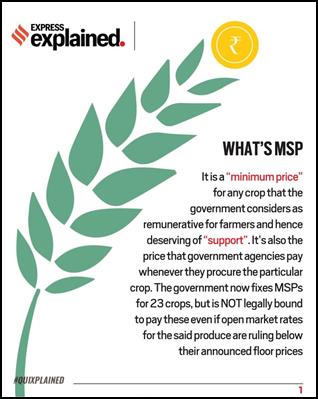
When was the MSP introduced in India?
- At the time of Independence, India was staring at a major deficit in terms of cereal production. After the struggling first decade, India decided to go for extensive agricultural reforms. It was the first time in the year 1966-67 that the Minimum Support Price was introducedby the Centre. At Rs 54 per quintal, the MSP for wheat was fixed for the first time.
What was the need of introducing MSP?
- On the path of the Green Revolution, Indian policymakers realized that the farmers needed incentives to grow food crops.
- Otherwise, they won’t opt for crops such as wheat and paddy as they were labour-intensive and didn’t fetch lucrative prices. Hence, to incentivize the farmers and boost production, the MSP was introduced in the 1960s.
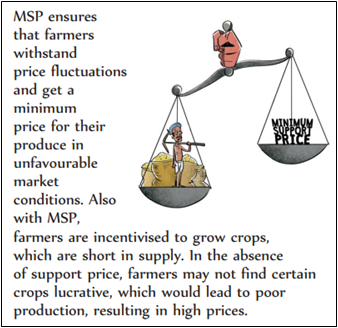
Calculating MSP
Since 2009, the Commission for Agricultural Costs and Prices fixes the MSP of a crop based on:
- Cost of production
- Demand
- Supply
- Price fluctuations
- Market price trends
- Different costs and
- International market prices
- Agricultural wage rate
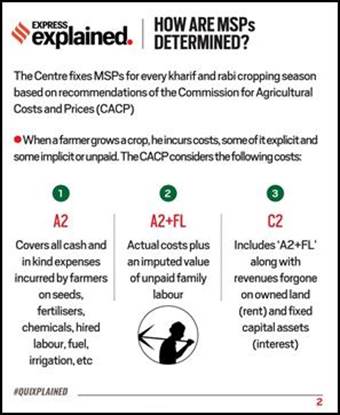
How the Govt. decides on the MSP?
- In India, there are two major cropping seasons, namely ‘Rabi’ and ‘Kharif’.
- The government announces the MSP at the start of each cropping season.
- The MSP is decided after the government exhaustively studies the major points made by the Commission for Agricultural Costs and Prices.
- These recommendations are based on some pre-fixed formulae. This includes the actual cost incurred, implicit family labour as well as fixed assets or rent paid by the farmers.
- In technical terms, these variables are called A2, FL and C2. The MSP is calculated by the government by often adding all these.
How many crops are covered under the MSP?
- Government announces minimum support prices (MSPs) for 22 mandated crops and fair and remunerative price (FRP) for sugarcane:
- Cereals (7) – paddy, wheat, barley, jowar, bajra, maize and ragi
- Pulses (5) – gram, arhar/tur, moong, urad and lentil
- Oilseeds (8) – groundnut, rapeseed/mustard, toria, soybean, sunflower seed, sesamum, safflower seed and niger seed
- Raw cotton
- Raw jute
- Copra
- De-husked coconut
- Sugarcane (Fair and remunerative price)
- Virginia flu cured (VFC) tobacco
- The Food Corporation of India (FCI), the nodal central agency of the Government of India, along with other State Agencies undertakes procurement of crops.
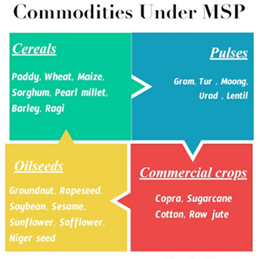
Is MSP legal?
- While Centre has been providing the MSP to the wheat and paddy farmers since mid-60s to tide over the food crisis, the fact remains that the MSP doesn’t have any legal stature.
Procurement
- The procurement at MSP is being done by Central and State Agencies under various schemes of Government.
- Procurement centres are opened by respective State Government Agencies and Central Nodal Agencies like NAFED, FCI etc.
- This is done after taking into account the production, marketable surplus, convenience of farmers
Pros of MSP
- One price policy. Assured pay. Directly influences farmer’s pocket. (Prices for all crops from 2009 to 2018.)
- Considers various factors when fixing the price, does not leave the farmer at the mercy of the market.
- Procurement for PDS and Buffer stock for food security come from this planning.
- Has a heavy influence on market prices. Also helps the farmer grow and match up with the other sectors in terms of income.
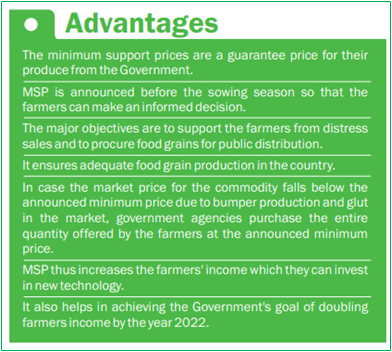
Cons of MSP & What can be done better:
- Hiking MSP without investing in infrastructure is just a short-term play. While it does deliver immediate results, long-term developments to back-it up are also important.
- MSP covers numerous costs. Like cost of sowing (A2), labour (FL), etc. These considerations are controversial with suggestions that it should be based on comprehensive costs (C2), which includes the land rent costs.
- Too much of an hike on MSP, either paves way for inflationary effects on the economy, with rise in prices of foodgrains and vegetables, or loss to government treasuryif it decides to sell at lower price as compared to the higher MSP it bought at.
- MSP is a nationwide single price policy. But the actual costing for production varies from place to place, more severely so in areas with lack of irrigation facilities and infrastructure. Thus, not all farmers have equal benefits.
- Market prices should ideally never be below MSP. If they fall below, in concept the farmer can always sell it to the government, which will then resell it or store as buffer. But practically this does not always happen.
- Market value in many cases does fall below MSP due to lack of infrastructure and procurement apparatus on government’s behalf.
- MSP is notified for 23 crops but effectively ensured only for two-three crops.
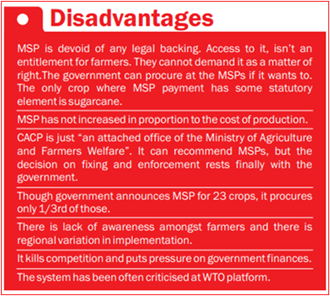
Thus, MSP while still being significant is not the only go to solution for solving all the woes for farmers.
Way Ahead
Direct Income Transfers
- Public procurement needs to continue for staple cereals, but farmers of non-staple food crops need to be provided with direct income transfers.These are fiscally prudent, obviate the need for physical procurement and storage by the government, do not distort current production, and also provide a basic income to farmers. These will also address the main concern over the recent farm laws related to the vulnerability of small and marginal farmers and may help these farmers to avoid distress sales.
Swaminathan Commission recommendation
- Swaminathan Commission prescribed MSP 50 per cent above C2.
Deficiency Price Payment
- The Govt. can also go for the alternative of ‘deficiency price payment’without requiring the government to purchase undesirable quantities and undesirable commodities.
- Deficiency price payment must be part of the difference between the actual price received by farmers and the MSP.
- Example: The Madhya Pradesh government has launched a ‘Price Deficiency Payment’ schemes for the farmers called ‘Bhavantar Bhugtan Yojana’ (BBY) in 2017.
https://agriculturepost.com/agribusiness/agri-marketing/cabinet-approves-minimum-support-prices-msp-for-copra-for-2023-season/#:~:text=The%20MSP%20for%20fair%20average,copra%20over%20the%20previous%20season.












